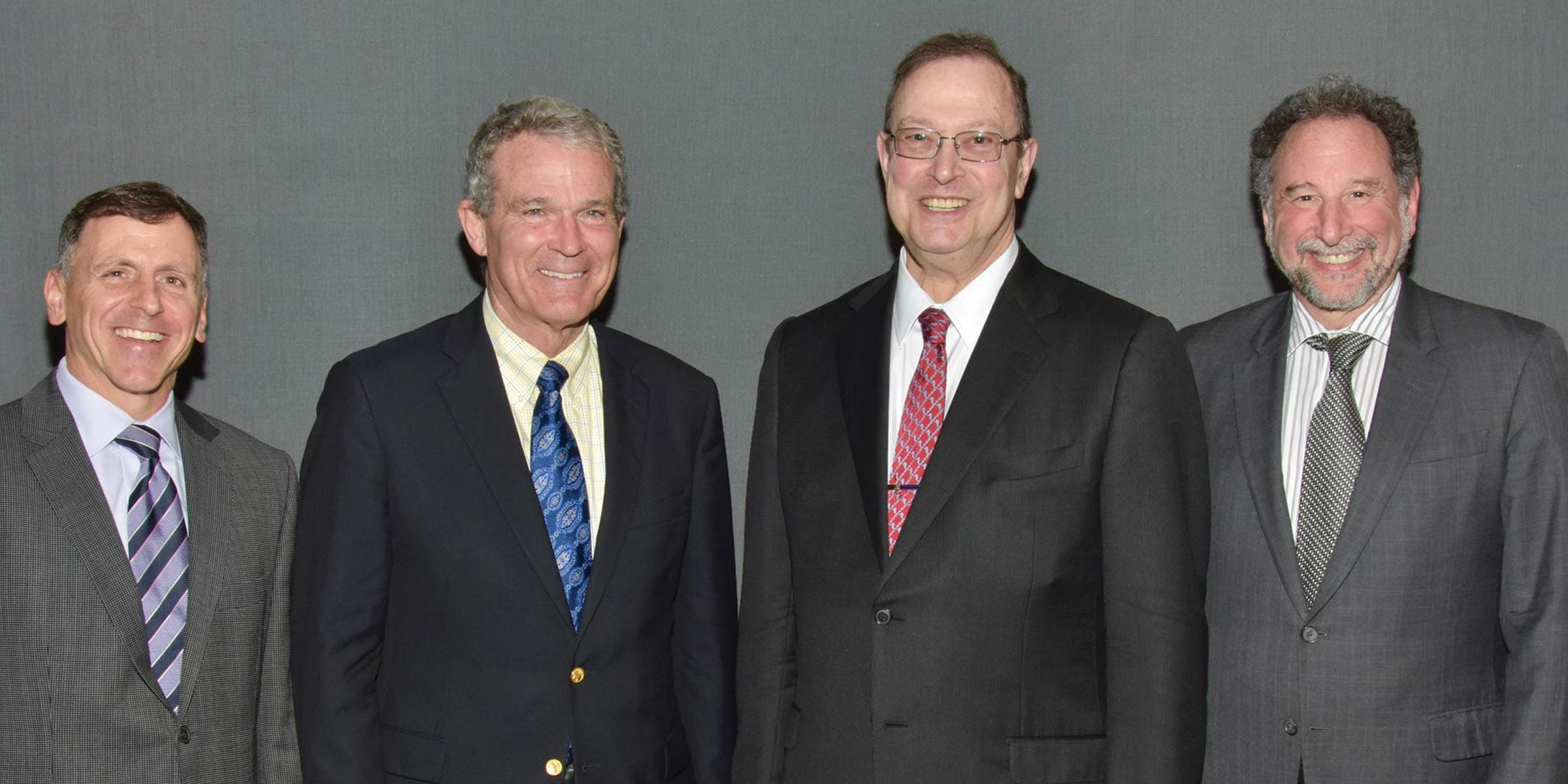20,000 surgeries later, James CEO reflects on legendary oncology career
Surgical oncologist William Farrar, MD, doffs his scrubs and prepares to retire as CEO of The James.
William Farrar, MD, had no idea what awaited him as he prepared to depart the operating room suite after performing his final surgery at Ohio State’s James Cancer Hospital and Solove Research Institute.
When the doors swung open and he stepped into a corridor en route to the locker room where he would remove his scrubs for the last time, thunderous applause and cheers erupted from dozens of colleagues who lined the walls in honor of his exit.
Startled, he accepted his white coat from a waiting colleague, pulled it on over his scrubs and shuffled unpretentiously down the corridor, offering a couple of quick modest waves, accepting a few hugs and at least once subtly shaking his head as if in disbelief at this heartfelt spectacle that was secretly arranged to chronicle the concluding steps of a surgical journey that had begun nearly half a century ago.
“I was completely shocked by the ‘clap-out’ ceremony,” says Dr. Farrar, an acclaimed surgical oncologist who also serves as CEO of The James, when reflecting on that March 21 magical moment.
“I didn’t think anyone knew – and I didn’t plan to share – that it was my last case. It was overwhelming to see so many colleagues. I really appreciated everyone being there. I feel honored to have spent my entire surgical career here at Ohio State and The James,” says Dr. Farrar.
After changing his clothes, he retreated to his office on 9 James and sat alone for a while, perhaps mulling over a storied career that began with his arrival at Ohio State in 1975 as a surgical resident and that would take another climactic turn when he announced on May 10 his decision to also soon retire as CEO of The James, which will end his nearly five-decade medical career at Ohio State.
What will be the extent of this man’s legacy?
“Dr. Farrar’s impact at Ohio State is the material of which legends will be made,” says fellow surgical oncologist Raphael Pollock, MD, PhD, FACS, director of The Ohio State University Comprehensive Cancer Center (OSUCCC).
To back his assertion, Dr. Pollock checks off a number of Dr. Farrar’s historical achievements: becoming the first surgical oncology fellow at Ohio State; performing cancer surgeries for an astounding 46 years; and being the last trainee of the late Arthur G. James, MD, known to still be practicing in 2022. Dr. James, who died in 2001, was a renowned surgical oncologist for whom the cancer hospital is named.
Over the decades, Dr. Farrar performed more than 20,000 surgeries on patients with nearly every kind of malignancy except brain cancer. Later in his career he began specializing in breast cancer care because most of his research and clinical trials were focused on that disease. He also was put in charge of breast cancer at The James and thus prioritized breast cancer surgery over all other types.
He also held several key administrative positions, including 28 years as director of the Division of Surgical Oncology in the Department of Surgery, 22 years as director of medical affairs at The James and a decade as the inaugural director of the Stefanie Spielman Comprehensive Breast Center. He still holds the Dr. Arthur G. and Mildred C. James – Richard J. Solove Chair in Surgical Oncology at the Ohio State College of Medicine, and he remains, for now, as CEO of The James, a position he gained on an interim basis in 2017 and in full in 2019.
In addition to his clinical career, Dr. Farrar has long been a researcher in the Molecular Carcinogenesis and Chemoprevention Program at the OSUCCC. He has authored or co-authored more than 100 clinical studies and reviews published in scientific journals, including studies on such subjects as genetic counseling and sentinel lymph node mapping/biopsy – a procedure to determine whether cancer cells have spread from the tumor to adjacent lymph nodes.
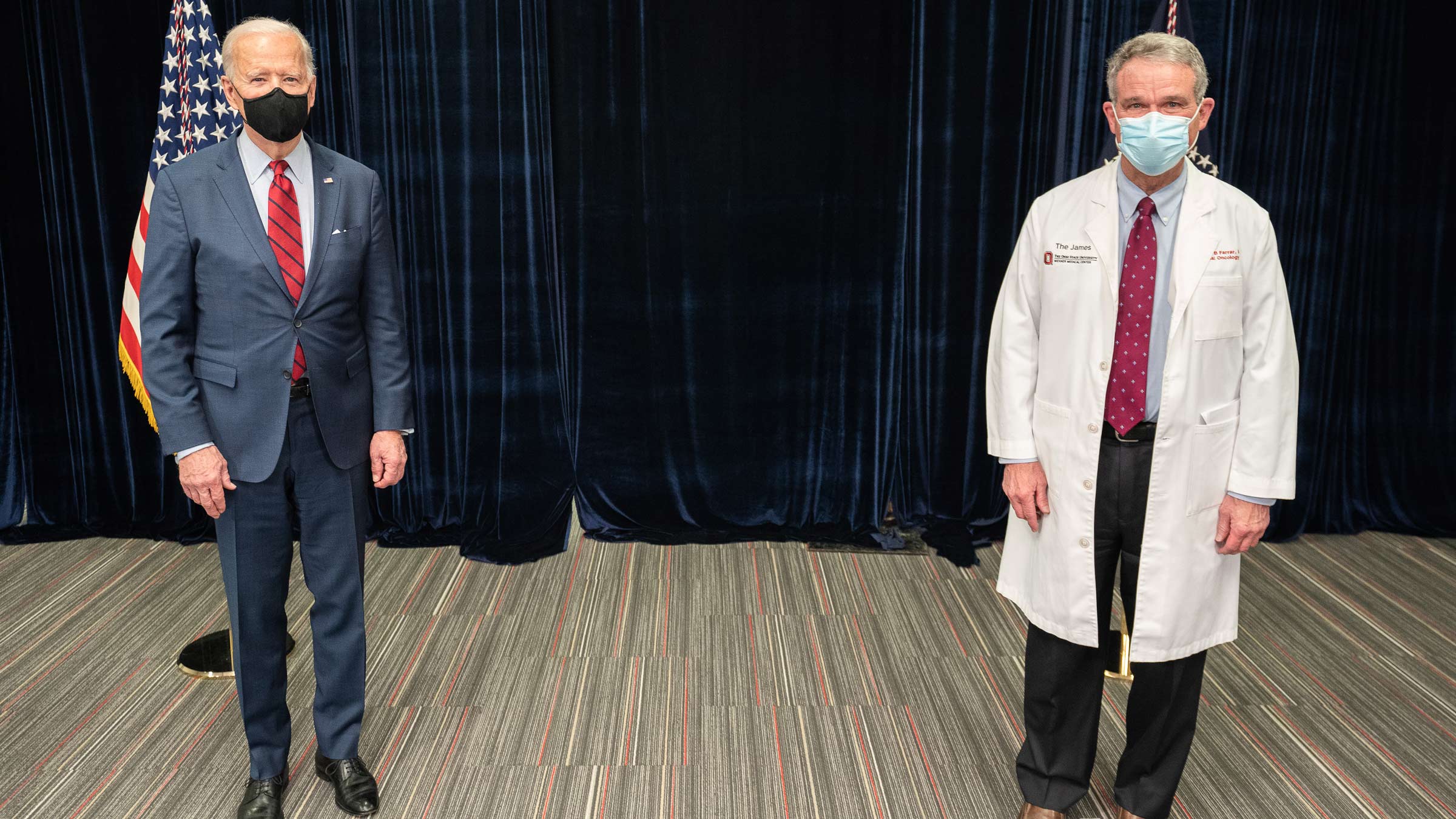
Dr. Farrar also has served as president of the U.S. National Committee for the International Union Against Cancer, as principal investigator for the National Surgical Adjuvant Breast and Bowel Project Clinical Trial group at Ohio State, and on numerous national committees.
Not bad for a man who once thought that, after finishing his surgical residency at Ohio State, he would return to his hometown of Aurora, Illinois, and practice general surgery.
“This plan completely changed when the chairman of surgery at Ohio State, Dr. Larry Carey, asked me to become the university’s first surgical oncology fellow and work for an entire year with Dr. James, who at the time was the premier surgical oncologist in the Midwest,” Dr. Farrar says.
“After a long discussion with my wife, Kathryn, I agreed. This started my career in surgical oncology,” Dr. Farrar says.After he finished his residency, his mentor recommended that he pursue a two-year fellowship at Memorial Sloan Kettering Cancer Hospital in New York City. When he returned, he became Dr. James’ surgical partner and worked with him until Dr. James retired from his surgical practice in 1990.
“I feel blessed to have trained with this man and to have worked alongside him for several years,” Dr. Farrar said after Dr. James died. “Dr. James was truly a gentleman; I never heard him raise his voice. Perhaps his greatest tributes were paid by his patients, who often spoke of his exemplary caring and compassion.”
Like master, like apprentice
Dr. Farrar shares those qualities.
“I’ve known Bill for about 50 years, and his career as both a cancer surgeon and administrator has always reflected a high integrity and intense commitment to his patients,” says David Schuller, MD, who was director of the OSUCCC from 1988-97, and director (and later CEO) of The James from 1988-2008. “Bill has always been intensely committed to our patients, and I will forever respect him and appreciate his impact on the thousands of people who interacted with him.”

“Bill’s longevity and accomplishments are based on several exemplary qualities that the rest of us seek to emulate with varying degrees of success,” says Dr. Pollock, who has known Dr. Farrar since the 1980s even though they trained and worked at different institutions before Dr. Pollock was recruited to Ohio State in 2013 after 31 years at MD Anderson Cancer Center in Houston.
“Bill deeply cares about his patients; it is unequivocally clear from the ‘get-go’ that this is his key motivation,” says Dr. Pollock.
“He’s a surgeon’s surgeon who performs at the highest level of technical commitment, but equally important are his personal humility, his quiet and professional persona, his quick smile and his very big heart.”
Dr. Pollock speaks from personal experience.
“After I had an emergency operation to remove my spleen at Ohio State in early 2017 due to a life-threatening listeria abscess,” he says, noting that he received a diagnosis of chronic lymphocytic leukemia soon after that operation, “Bill was the first person outside of my family to find me as an inpatient and make sure I was OK, and that my family had his contact information so he could be found at any time if needed. I remain grateful for his concern and presence at that critical juncture.”
Electra Paskett, PhD, MSPH, associate director for population science and community outreach at the OSUCCC – James, has known Dr. Farrar since she arrived at Ohio State in 2002 from Wake Forest University. She too can vouch for both his compassion and his humor.
“He gets along with everyone, speaks his mind and is passionate for the things he cares about, including his patients,” says Dr. Paskett, a three-time breast cancer survivor who adds that Dr. Farrar was her surgeon during her last bout with the disease. “Because I’ve had it three times but we can’t find any (underlying) genetic mutation, he told me there was probably a ‘BRCA EP’ gene that accounted for my cancers.”
(BRCA1 and BRCA2 are tumor-suppressor genes that, when mutated, can cause breast and other forms of cancer; Dr. Farrar’s comical “EP” add-on represents Dr. Paskett’s initials.)
“He’s incredibly funny and personable, and a fabulous storyteller,” says Amy Ware, MHA, MEd, who has been senior adviser to the CEO for the past few years.
“When I began in this role, it only took a few seconds for me to understand how special he is. Dr. Farrar is extremely kind, compassionate and 100% focused on delivering the best possible care to our patients,” Ware says.
Ware adds that, in connecting with hundreds of Dr. Farrar’s patients over the years, she and others in the cancer program have been inspired by their admiration for him and for his genuine concern not only for them, but for their families and interests.
That personal bond may explain why he had a difficult time deciding when to walk away from his work.
After he was named the 2021 recipient of the Distinguished Alumnus(a) Award at Illinois Wesleyan University (IWU), where he earned his undergraduate degree in 1971, Dr. Farrar told an interviewer that caring for patients with cancer is “something I have truly found worthwhile and meaningful.”
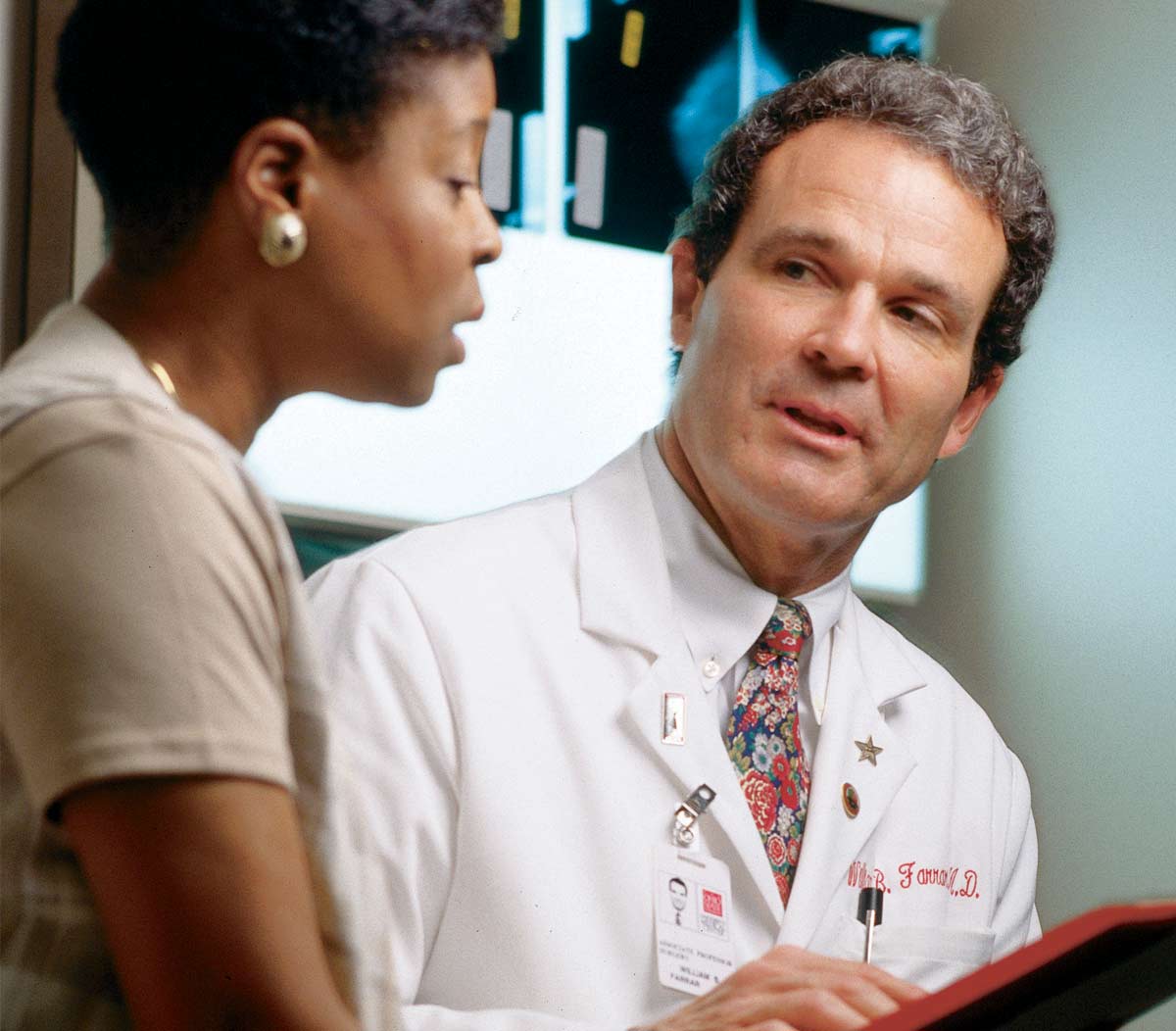
“It’s been tough to figure out when I should retire because I really feel that taking care of patients with cancer is my purpose.”
Reflecting on his education, where he learned to ‘rise and recover’
But his career path hasn’t always been smooth, as he told the IWU Class of 2022 when he recently delivered their spring commencement address on the same weekend that he received his IWU Distinguished Alumnus Award and an IWU honorary Doctor of Humane Letters degree, which is bestowed upon those who have distinguished themselves through humanitarian and philanthropic contributions to society.
“My pathway to the present wasn’t always easy,” Dr. Farrar said. “There were potholes, steep grades and rugged terrain. For example, in academics I’m wired more for science and math than for English and humanities. But when I was a student at IWU, you had to pass a particular humanities course before you could graduate. I saved this class for my senior year, figuring that if I put it off long enough, I could somehow evade it.”
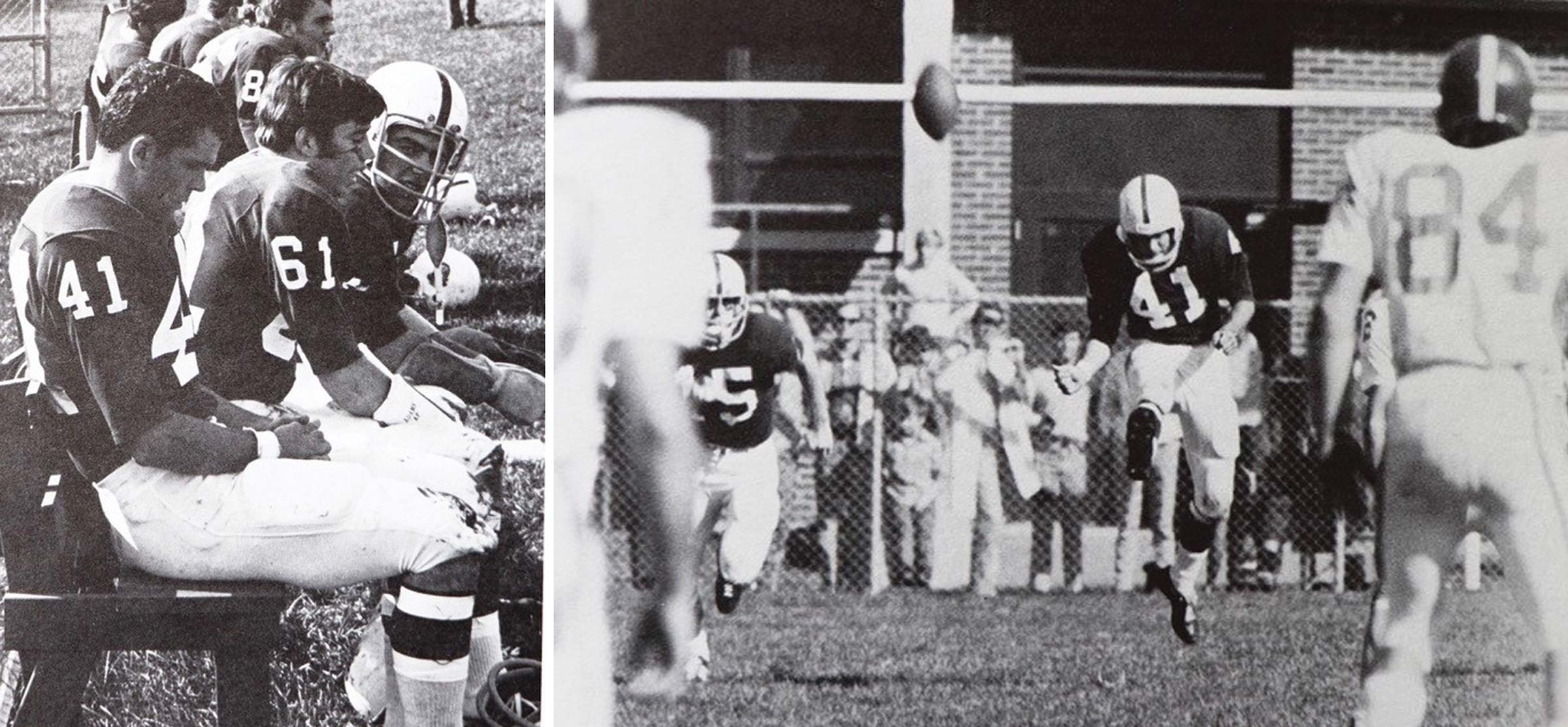
Not so. And once he was in the class, he was sure he would fail. “I struggled and worried my way through it, sometimes fearing the worst.” After his final exam, his professor “called me at my fraternity house to share the surprising news that I had somehow passed the course. So, with grit, grace and a lot of prayers, I had met all of the requirements for graduating and could move on to medical school.”
After arriving at the University of Virginia for medical school, he faced more uncertainty.
“I became concerned when I learned that many of my classmates had graduated from Ivy League schools such as Harvard, Yale, Cornell and Brown. But I quickly realized I was going to do OK,” he recounted in his commencement address, noting that his excellent IWU education had prepared him well for demanding curriculum and stiff competition. “I may not have been as smart as some of the others, but I was better prepared than most.”
Dr. Farrar shared with the IWU Class of 2022 an important lesson he learned during his undergraduate and medical school years: “Although everyone will face obstacles and setbacks along their way, all of us can overcome them if we are fueled by perseverance and a desire to always do more. What matters most is how you rise to face your challenges and respond to your failures. Do you quit, or do you try harder?
“Don’t be afraid of failure,” he said, pointing out that he has had many failures.
“In the human experience, failing is inevitable, but bouncing back is not. That part is up to us; we all have it within ourselves to rise and recover. And if you do, then, like me, you will get to where you want to go.”
A vantage point to observe radical changes in cancer diagnosis and treatment
In getting there, he has seen monumental changes in cancer treatment that have stemmed from basic research and clinical trials involving patients who were willing to try new therapies.
“When I started taking care of patients with breast cancer, the decision tree was very simple,” he says, explaining that he would surgically remove a lump from a patient’s breast, obtain a pathology report and, if the lump were found to be malignant, perform a radical mastectomy that included removal of the skin of the chest wall, all of the breast tissue, all of the muscles along the chest wall and all of the lymph nodes in the axillary area (under the arm).
“No further treatment would be recommended,” Dr. Farrar says. “When the patient went to surgery, she would not know whether she would wake up with breasts or whether I would have had to remove them. Breast reconstruction was not an option.”
Nowadays, the scenario is drastically different
“A patient comes in with a lump – or more commonly with an abnormal result from a mammogram, ultrasound or MRI – and then a biopsy is performed, and a pathology report is obtained,” Dr. Farrar says. “If the report is positive for cancer, the cancer cells are tested to see if they have estrogen or progesterone receptors, which are important in tumor growth. Once all the data is evaluated, a decision is made about whether the patient should have a lumpectomy, a sentinel node biopsy or a total mastectomy, and whether breast reconstruction is an option.
“These advances are simply incredible,” he adds, “and they are all due to patients participating in hundreds of clinical trials,” including some landmark national trials in which Ohio State participated. One of those trials demonstrated that the drug tamoxifen reduced the risk of breast cancer by 49%, making it the first drug known to prevent rather than just treat breast cancer. Drs. Farrar and Schuller discussed these breakthrough results at a press conference at The James in 1998.
“It used to be that when you told people you were an oncologist, they would get a look of gloom on their face, as if to say, ‘I am so sorry for you,’” Dr. Farrar recalls. “But because of research discoveries and new treatments, oncologists can be much more optimistic with their patients about their outcomes and how they will tolerate treatment.
“I can’t take credit for originating or leading the major national clinical trials, but as a principal investigator at Ohio State I’ve assisted in writing many other clinical trials that have examined the effects of different treatment options, and I have participated in randomizing patients to these trials so we could offer them groundbreaking care. Dedicating time to research gives me a sense of hope, and I feel deep satisfaction when our research translates into benefits for patients.”
Laying the foundation for future oncologists and cancer treatment
For many years, Dr. Farrar led the oncology fellowship program at Ohio State and The James. Besides training medical students and residents, he also educated 71 fellows to become surgical oncologists. “I’m proud to say that many of these physicians have become national leaders since their training,” he says.
Dr. Farrar also considers himself fortunate to have worked with The James Foundation Board on such construction projects as the original cancer hospital that opened at Ohio State in 1990, the newer and much larger cancer hospital that replaced it in 2014 and the Stefanie Spielman Comprehensive Breast Center that opened in 2011 as the first of its kind in the Midwest, offering a full continuum of breast cancer care – from prevention and screening through detection, diagnosis, treatment and survivorship.
The Stefanie Spielman Comprehensive Breast Center, which Dr. Farrar led for 10 years after it opened, is named for a patient of his who died in 2009 at age 42 after an 11-year battle with breast cancer. During those years, Stefanie and her husband, Chris, a former Ohio State and professional football standout, worked tirelessly to heighten awareness about breast cancer and raise funds for research. Since 1998, more than $26 million has been raised for the Stefanie Spielman Fund for Breast Cancer Research at the OSUCCC – James.
Chris Spielman, who has remained active in furthering Stefanie’s legacy and advocating for the OSUCCC – James, recognizes Dr. Farrar’s longstanding importance to Ohio State’s cancer program. “He’s a man who has done his job with compassion, excellence and an unrelenting will to defeat cancer,” Spielman says. “Well done, my friend!”
Dr. Farrar also has had a hand, along with many others, in developing a new cancer-focused facility on Ohio State’s West Campus, a nine-story building slated to open in 2023. “This 385,000-square-foot outpatient clinic will give us more operating rooms and clinical spaces, but it also will enable us to provide such innovative radiation treatments as proton therapy and FLASH therapy to both adult and pediatric patients in partnership with Nationwide Children’s Hospital,” he says.
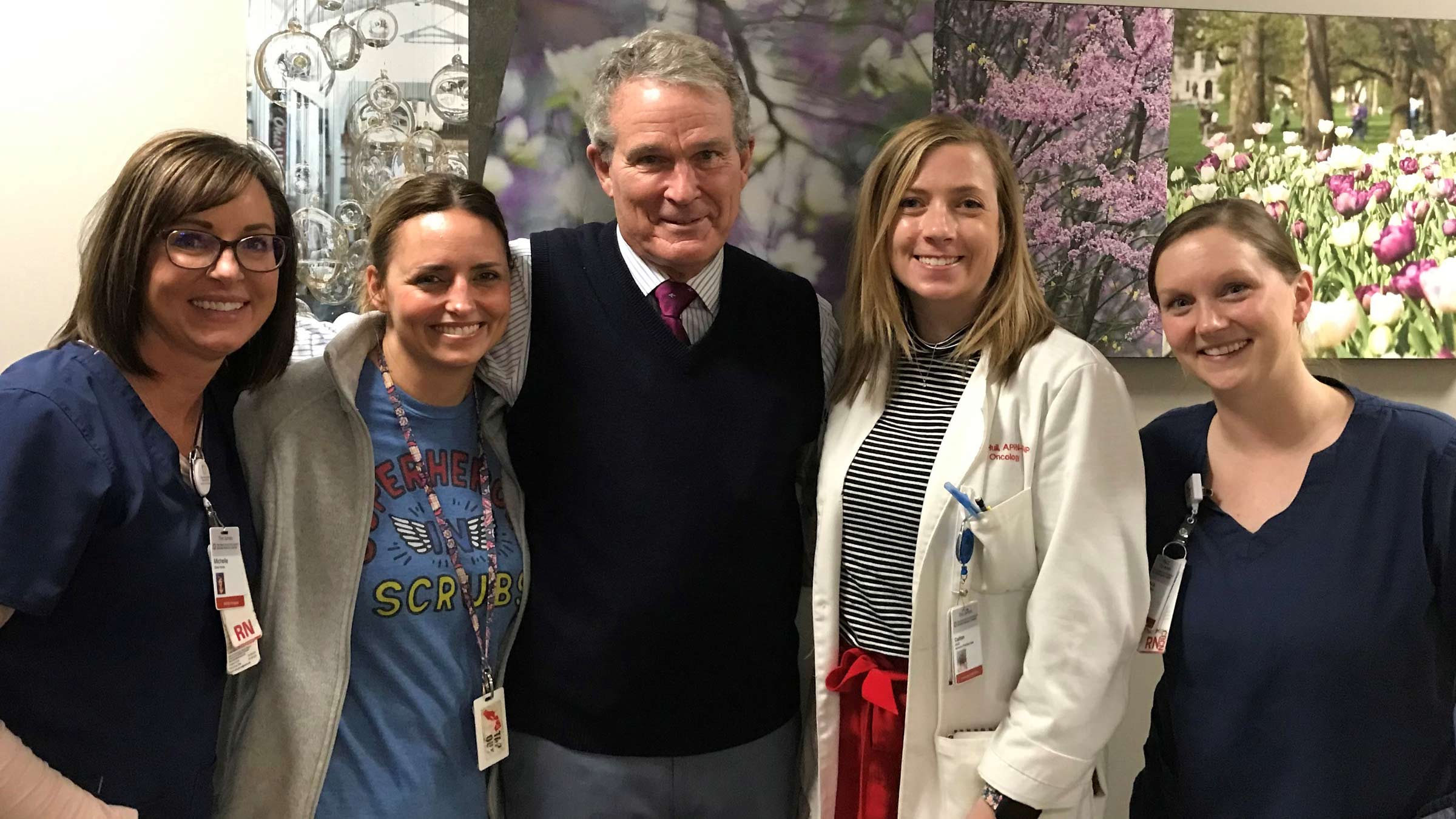
Departing with hope
Continuous innovations and advances brought about by medical scientists at the OSUCCC – James and elsewhere make Dr. Farrar optimistic about the global fight against cancer at a point when he is about to leave the arena.
“I’m proud of our collective accomplishments, but the work to end cancer is ongoing,” he says. “I’m grateful to have been a part of so many efforts to move us forward and for the opportunity to make a difference in people’s lives.”
He also attributes much of his success to his wife, Kathryn, and their four children.

“None of this would have been possible without them. Kathryn is the rock of our family, and I couldn’t have accomplished anything without her by my side.”
Will it be difficult to end his long career journey?
“It’s hard to wrap my mind around no longer performing surgeries, but I am thankful to have spent my career at a place I love, surrounded by so many great patients, colleagues and friends,” Dr. Farrar says.
“This cancer community is unlike any other I’ve ever experienced – just the most fantastic people who are compassionate and driven to deliver the best possible care for our patients.”
And among those fantastic folks, Dr. William Farrar will forever be remembered.

Your support fuels our vision to create a cancer-free world
Your support of cancer care and pioneering research at Ohio State can make a difference in the lives of today’s patients while supporting our work to improve treatment and reduce cases tomorrow.
Ways to Give





